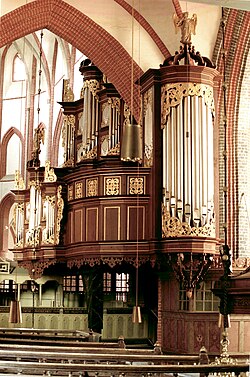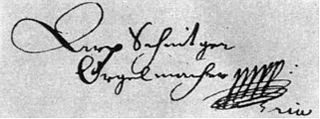
Arp Schnitger was an influential Northern German organ builder. Considered the paramount manufacturer of his time, Schnitger built or rebuilt over 150 organs. He was primarily active in Northern Europe, especially the Netherlands and Germany, where a number of his instruments still survive.

The organ of the St. Jacobi Church in Hamburg, was built from 1689 to 1693 by the most renowned organ builder of his time, Arp Schnitger. The organ boasts four manuals and pedal with 60 stops, 15 of which are reeds – and has approximately 4000 sounding pipes. All in all, from the organ's original installation and its condition today not much of its conception has changed. The old pipework and the prospect pipes have been preserved in almost original format. It is the largest organ in existence from before 1700 and is one of the most eminent Baroque instruments that have been preserved.

Harald Vogel is a German organist, organologist, and author. He is a leading expert on Renaissance and Baroque keyboard music. He has been professor of organ at the University of the Arts Bremen since 1994.
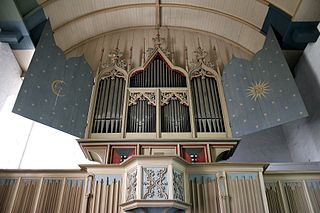
The Rysum organ in Rysum Church in Rysum, north Germany, is the oldest instrument of its kind in northern Europe that still largely has its original pipes. It is also one of the oldest playable church organs in the world alongside those in Sion, St. Valentin in Kiedrich, and Ostönnen. The exact date of its construction is not entirely known, but dates of 1457 and 1440 have been proposed. It was rebuilt in 1513. After undergoing several other modifications through the years it was restored to its 1513 condition by Jürgen Ahrend and Gerhard Brunzema in 1959. The organ has seven stops on one manual.
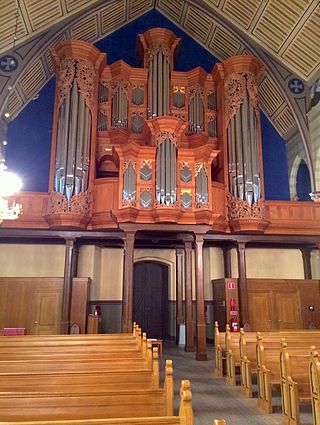
The North German baroque organ in Örgryte Nya Kyrka is a pipe organ in Gothenburg. It was built within a research project at GOArt, University of Gothenburg and dedicated on August 12, 2000. The goal of the project was to recreate the construction techniques and design philosophies of 17th-century German organbuilder Arp Schnitger. Even though the instrument was built in the style of this single builder it was not modeled after a single instrument. No single model could be used since no large Schnitger organ has been preserved in original condition. The construction of the organ was carried out by an international team of organ builders. Henk van Eeken was responsible for the design and the technical drawings, Munetaka Yokota for the pipe work and Mats Arvidsson oversaw the building process. The instrument contains almost 4000 pipes and is the largest existing organ tuned in quarter-comma meantone.
Pipe organs that are tuned in meantone temperament are very rare in North America. They are listed here, by type of temperament and sorted by date of construction. North America is defined here as Canada, the United States of America and Mexico. All instruments listed are playable but unplayable instruments may be added with a note.

The Church of Reinhardtsgrimma is a Lutheran parish church in Reinhardtsgrimma, a part of Glashütte in Sächsische Schweiz-Osterzgebirge in Saxony, Germany. It contains a pipe organ built in 1731 to the designs of Gottfried Silbermann.

The Jacobikerk organ in Uithuizen in the Dutch province of Groningen was built in 1701 by Arp Schnitger. It has 28 stops which are distributed on two manuals and pedal. The instrument is one of the best preserved Schnitger organs. The organ has been used as a template for newly built organs in the 20th century and for the reconstruction of lost stops of other Schnitger organs.

The west gallery organ of the Martinikerk in Groningen dates from the 15th century; it took its present form in the 18th century when it was expanded by Arp Schnitger, his son Franz Caspar Schnitger and his successor Albertus Antonius Hinsz. It has 52 speaking stops on three manuals and pedal, and is one of the largest and most famous baroque organs in Northern Europe.

The organ of the Dorpskerk in Noordbroek in the Dutch province of Groningen was first built in 1696 by Arp Schnitger. Today it has 24 stops over two manuals and pedal. The case and the disposition are largely preserved as they were in 1809.
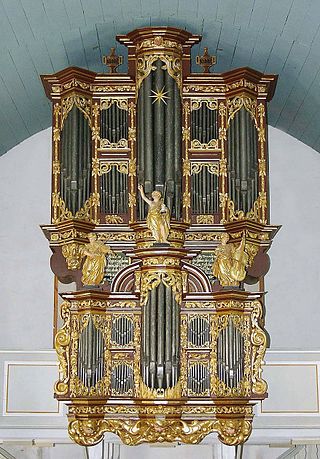
The organ of St. Peter and Paul in Cappel was built in 1680 by Arp Schnitger for the St. Johannis-Klosterkirche in Hamburg and has been in Cappel, Lower Saxony since 1816. It is considered to be the most complete and sonically best-preserved organ from the late 17th century in northern Germany. The instrument has two manuals with pedal and 30 stops, of which only two are not entirely old. Helmut Walcha's recordings of Bach's organ works (1950–1952) made this instrument world-famous.
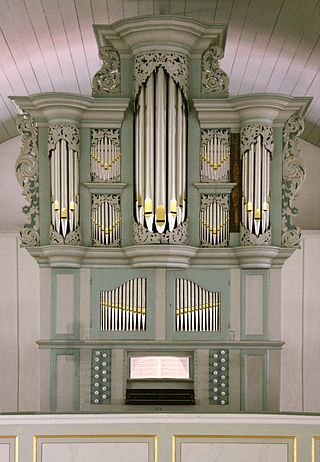
The organ of the Grasberg church, or Findorffkirche, in Grasberg was built in 1693–1694 by Arp Schnitger, originally for the orphanage at Rödingsmarkt in Hamburg, and transferred to Grasberg in 1788. It is one of the few instruments by Schnitger to have been structurally changed as early as the 18th century. The organ has 21 stops, over two manuals and pedal. 15 stops are still original Schnitger work.

The organ of the St. Pankratius in Hamburg-Neuenfelde was built in 1688 by Arp Schnitger, and is his largest two-manual organ. The instrument has 34 stops, of which about half are original. Neuenfelde itself belongs to the Altes Land and was incorporated to Hamburg in 1937.

The west gallery organ in the Aa-kerk in Groningen was built by Arp Schnitger in 1699–1702. Originally built for the Academiekerk in Groningen it was moved to the Aa-kerk in 1815. Today it has 40 stops on three manuals and pedal, and is a monument of European significance.
Stef Tuinstra is a Dutch organist, organ expert and author.
Johann Michael Röder was a German organ builder in Berlin and Silesia from the first half of the 18th century. He was a pupil of Arp Schnitger.
Regina Stegemann is an organ builder from East Frisia who specialises in the restoration of historic organs, but also carries out maintenance and rebuilding work. New builds are carried out exclusively with mechanical slider chests. Her area of work is concentrated on East Frisia, the Oldenburg Land and the Wesermarsch.
Johann Hinrich Klapmeyer was a German organ builder.

Bernhardt Hilbrand Edskes was a Dutch-Swiss organist, organologist, and organ builder based in Wohlen.
Franz Caspar Schnitger was a German organ-builder active in the Netherlands.
